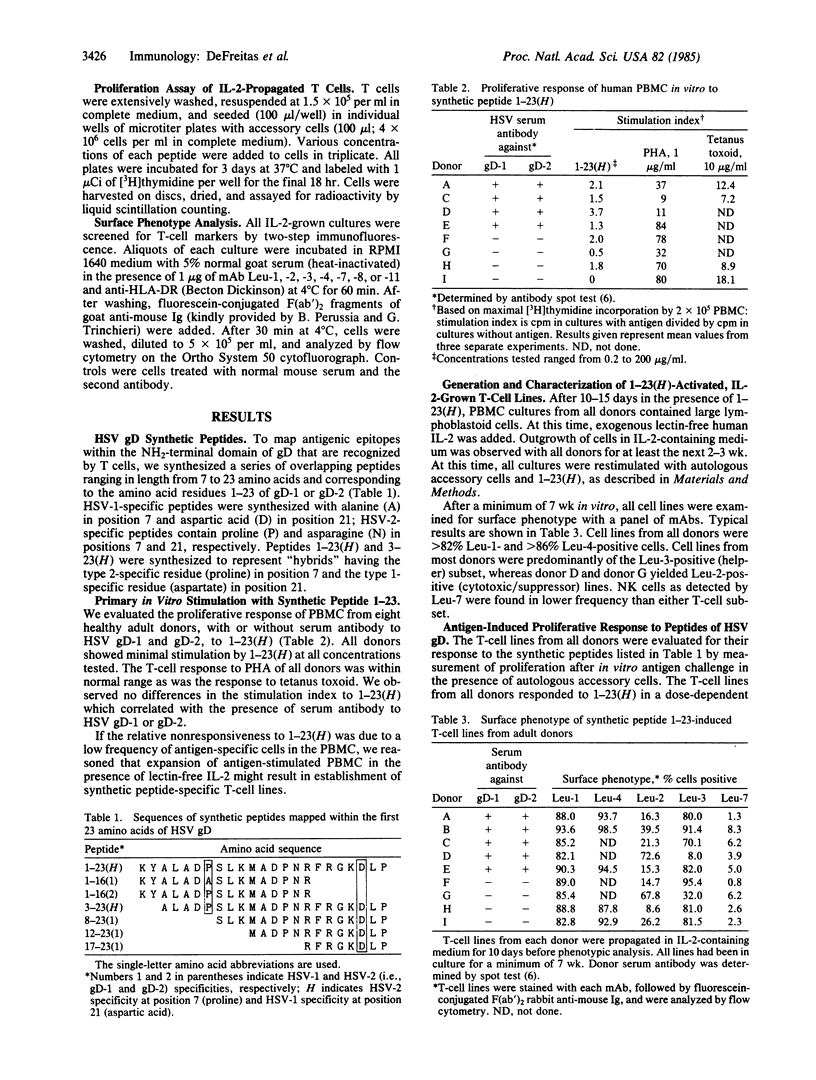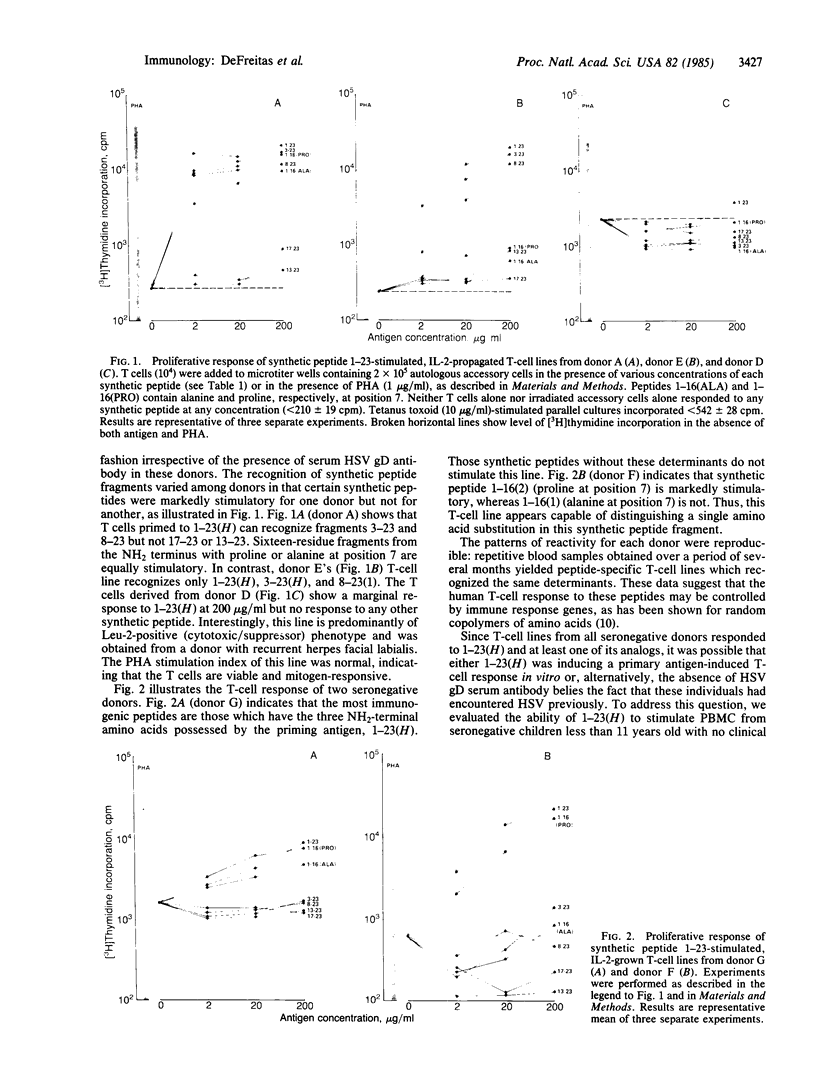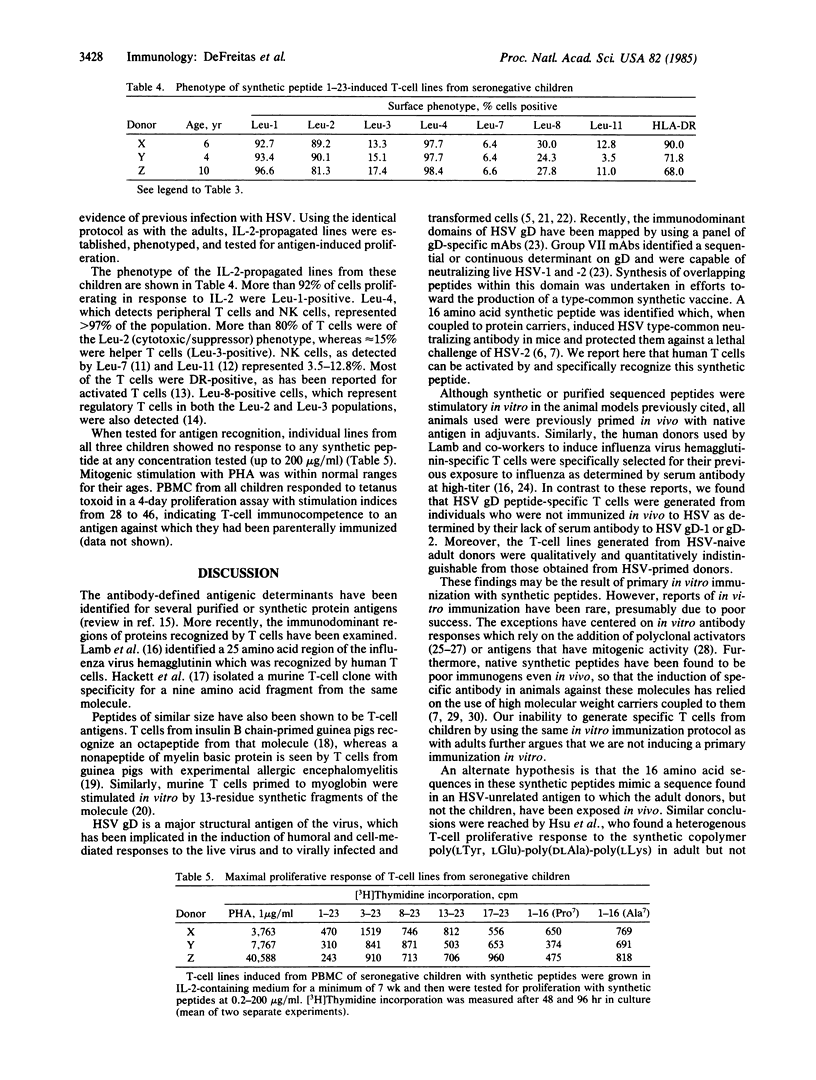Abstract
Immunization of mice with a synthetic peptide that corresponds to a murine antibody-defined immunodominant domain of herpes simplex virus (HSV) glycoprotein D (gD) induced neutralizing antibodies against HSV types 1 and 2 and protected animals against a lethal challenge with HSV type 2 (Dietzschold, B., Eisenberg, R., Ponce de Leon, M., Golub, E., Hudecz, F., Varicchio, A. & Cohen, G. (1984) J. Virol. 52, 431-435). We report here that human peripheral blood T cells from HSV-seropositive and -seronegative adult donors are activated by this synthetic peptide in vitro. Interleukin-2-dependent T-cell lines established from these cultures respond specifically to peptides containing residues 1-23 of HSV gD and to a panel of overlapping peptides within this domain. The T-cell proliferative response was maximal when the majority of interleukin-2-propagated T cells were of the helper phenotype and the peptides were at least 16 amino acids long. Peptides of 8 or 12 amino acids from the carboxyl terminus were nonstimulatory. Peptide-activated T-cell lines from sero-negative donors less than 11 years old could be established in vitro, but most cells were of the suppressor/cytotoxic phenotype and demonstrated no antigen-specificity when tested with the panel of synthetic peptides.
Full text
PDF




Images in this article
Selected References
These references are in PubMed. This may not be the complete list of references from this article.
- Abo T., Balch C. M. A differentiation antigen of human NK and K cells identified by a monoclonal antibody (HNK-1). J Immunol. 1981 Sep;127(3):1024–1029. [PubMed] [Google Scholar]
- Arnon R. Experimental allergic encephalomyelitis--susceptibility and suppression. Immunol Rev. 1981;55:5–30. doi: 10.1111/j.1600-065x.1981.tb00337.x. [DOI] [PubMed] [Google Scholar]
- Atassi M. Z. Precise determination of protein antigenic structures has unravelled the molecular immune recognition of proteins and provided a prototype for synthetic mimicking of other protein binding sites. Mol Cell Biochem. 1980 Aug 29;32(1):21–43. doi: 10.1007/BF00421293. [DOI] [PubMed] [Google Scholar]
- Balachandran N., Bacchetti S., Rawls W. E. Protection against lethal challenge of BALB/c mice by passive transfer of monoclonal antibodies to five glycoproteins of herpes simplex virus type 2. Infect Immun. 1982 Sep;37(3):1132–1137. doi: 10.1128/iai.37.3.1132-1137.1982. [DOI] [PMC free article] [PubMed] [Google Scholar]
- Ballieux R. E., Heijnen C. J. Immunoregulatory T cell subpopulations in man: dissection by monoclonal antibodies and Fc-receptors. Immunol Rev. 1983;74:5–28. doi: 10.1111/j.1600-065x.1983.tb01082.x. [DOI] [PubMed] [Google Scholar]
- Bishop G. A., Glorioso J. C., Schwartz S. A. Relationship between expression of herpes simplex virus glycoproteins and susceptibility of target cells to human natural killer activity. J Exp Med. 1983 May 1;157(5):1544–1561. doi: 10.1084/jem.157.5.1544. [DOI] [PMC free article] [PubMed] [Google Scholar]
- Bittle J. L., Houghten R. A., Alexander H., Shinnick T. M., Sutcliffe J. G., Lerner R. A., Rowlands D. J., Brown F. Protection against foot-and-mouth disease by immunization with a chemically synthesized peptide predicted from the viral nucleotide sequence. Nature. 1982 Jul 1;298(5869):30–33. doi: 10.1038/298030a0. [DOI] [PubMed] [Google Scholar]
- Cohen G. H., Dietzschold B., Ponce de Leon M., Long D., Golub E., Varrichio A., Pereira L., Eisenberg R. J. Localization and synthesis of an antigenic determinant of herpes simplex virus glycoprotein D that stimulates the production of neutralizing antibody. J Virol. 1984 Jan;49(1):102–108. doi: 10.1128/jvi.49.1.102-108.1984. [DOI] [PMC free article] [PubMed] [Google Scholar]
- Cohen G. H., Katze M., Hydrean-Stern C., Eisenberg R. J. Type-common CP-1 antigen of herpes simplex virus is associated with a 59,000-molecular-weight envelope glycoprotein. J Virol. 1978 Jul;27(1):172–181. doi: 10.1128/jvi.27.1.172-181.1978. [DOI] [PMC free article] [PubMed] [Google Scholar]
- Cohen G. H., Ponce de Leon M., Nichols C. Isolation of a herpes simplex virus-specific antigenic fraction which stimulates the production of neutralizing antibody. J Virol. 1972 Nov;10(5):1021–1030. doi: 10.1128/jvi.10.5.1021-1030.1972. [DOI] [PMC free article] [PubMed] [Google Scholar]
- Delfraissy J. F., Galanaud P., Dormont J., Wallon C. Primary in vitro antibody response from human peripheral blood lymphocytes. J Immunol. 1977 Feb;118(2):630–635. [PubMed] [Google Scholar]
- Dietzschold B., Eisenberg R. J., Ponce de Leon M., Golub E., Hudecz F., Varrichio A., Cohen G. H. Fine structure analysis of type-specific and type-common antigenic sites of herpes simplex virus glycoprotein D. J Virol. 1984 Nov;52(2):431–435. doi: 10.1128/jvi.52.2.431-435.1984. [DOI] [PMC free article] [PubMed] [Google Scholar]
- Eisenberg R. J., Long D., Pereira L., Hampar B., Zweig M., Cohen G. H. Effect of monoclonal antibodies on limited proteolysis of native glycoprotein gD of herpes simplex virus type 1. J Virol. 1982 Feb;41(2):478–488. doi: 10.1128/jvi.41.2.478-488.1982. [DOI] [PMC free article] [PubMed] [Google Scholar]
- Eisenberg R. J., Ponce de Leon M., Pereira L., Long D., Cohen G. H. Purification of glycoprotein gD of herpes simplex virus types 1 and 2 by use of monoclonal antibody. J Virol. 1982 Mar;41(3):1099–1104. doi: 10.1128/jvi.41.3.1099-1104.1982. [DOI] [PMC free article] [PubMed] [Google Scholar]
- Engleman E. G., Warnke R., Fox R. I., Dilley J., Benike C. J., Levy R. Studies of a human T lymphocyte antigen recognized by a monoclonal antibody. Proc Natl Acad Sci U S A. 1981 Mar;78(3):1791–1795. doi: 10.1073/pnas.78.3.1791. [DOI] [PMC free article] [PubMed] [Google Scholar]
- Epstein L. B., Kreth H. W., Herzenberg L. A. Fluorescence-activated cell sorting of human T and B lymphocytes. II. Identification of the cell type responsible for interferon production and cell proliferation in response to mitogens. Cell Immunol. 1974 Jun;12(3):407–421. doi: 10.1016/0008-8749(74)90097-5. [DOI] [PubMed] [Google Scholar]
- Fauci A. S., Pratt K. R. Activation of human B lymphocytes. I. Direct plaque-forming cell assay for the measurement of polyclonal activation and antigenic stimulation of human B lymphocytes. J Exp Med. 1976 Sep 1;144(3):674–684. doi: 10.1084/jem.144.3.674. [DOI] [PMC free article] [PubMed] [Google Scholar]
- Gatenby P. A., Kansas G. S., Xian C. Y., Evans R. L., Engleman E. G. Dissection of immunoregulatory subpopulations of T lymphocytes within the helper and suppressor sublineages in man. J Immunol. 1982 Nov;129(5):1997–2000. [PubMed] [Google Scholar]
- Green N., Alexander H., Olson A., Alexander S., Shinnick T. M., Sutcliffe J. G., Lerner R. A. Immunogenic structure of the influenza virus hemagglutinin. Cell. 1982 Mar;28(3):477–487. doi: 10.1016/0092-8674(82)90202-1. [DOI] [PubMed] [Google Scholar]
- Hackett C. J., Dietzschold B., Gerhard W., Ghrist B., Knorr R., Gillessen D., Melchers F. Influenza virus site recognized by a murine helper T cell specific for H1 strains. Localization to a nine amino acid sequence in the hemagglutinin molecule. J Exp Med. 1983 Aug 1;158(2):294–302. doi: 10.1084/jem.158.2.294. [DOI] [PMC free article] [PubMed] [Google Scholar]
- Hilleman M. R. Herpes simplex vaccines. Cancer Res. 1976 Feb;36(2 Pt 2):857–858. [PubMed] [Google Scholar]
- Hoffmann M. K. Antigen-specific induction and regulation of antibody synthesis in cultures of human peripheral blood mononuclear cells. Proc Natl Acad Sci U S A. 1980 Feb;77(2):1139–1143. doi: 10.1073/pnas.77.2.1139. [DOI] [PMC free article] [PubMed] [Google Scholar]
- Hsu S. H., Chan M. M., Bias W. B. Genetic control of major histocompatibility complex-linked immune responses to synthetic polypeptides in man. Proc Natl Acad Sci U S A. 1981 Jan;78(1):440–444. doi: 10.1073/pnas.78.1.440. [DOI] [PMC free article] [PubMed] [Google Scholar]
- Hunkapiller M. W., Hood L. E. Direct microsequence analysis of polypeptides using an improved sequenator, a nonprotein carrier (polybrene), and high pressure liquid chromatography. Biochemistry. 1978 May 30;17(11):2124–2133. doi: 10.1021/bi00604a016. [DOI] [PubMed] [Google Scholar]
- Lamb J. R., Eckels D. D., Lake P., Woody J. N., Green N. Human T-cell clones recognize chemically synthesized peptides of influenza haemagglutinin. Nature. 1982 Nov 4;300(5887):66–69. doi: 10.1038/300066a0. [DOI] [PubMed] [Google Scholar]
- Lamb J. R., Eckels D. D., Phelan M., Lake P., Woody J. N. Antigen-specific human T lymphocyte clones: viral antigen specificity of influenza virus-immune clones. J Immunol. 1982 Mar;128(3):1428–1432. [PubMed] [Google Scholar]
- Lanier L. L., Le A. M., Phillips J. H., Warner N. L., Babcock G. F. Subpopulations of human natural killer cells defined by expression of the Leu-7 (HNK-1) and Leu-11 (NK-15) antigens. J Immunol. 1983 Oct;131(4):1789–1796. [PubMed] [Google Scholar]
- Luzzati A. L., Hengartner H., Schreier M. H. Induction of plaque-forming cells in cultured human lymphocytes by combined action of antigen and EB virus. Nature. 1977 Sep 29;269(5627):419–420. doi: 10.1038/269419a0. [DOI] [PubMed] [Google Scholar]
- Nagafuchi S., Hayashida I., Higa K., Wada T., Mori R. Role of Lyt-1 positive immune T cells in recovery from herpes simplex virus infection in mice. Microbiol Immunol. 1982;26(4):359–362. doi: 10.1111/j.1348-0421.1982.tb00186.x. [DOI] [PubMed] [Google Scholar]
- Nahmias A. J., Shore S. L., Kohl S., Starr S. E., Ashman R. B. Immunology of herpes simplex virus infection: relevance to herpes simplex virus vaccines and cervical cancer. Cancer Res. 1976 Feb;36(2 Pt 2):836–844. [PubMed] [Google Scholar]
- Nash A. A., Field H. J., Quartey-Papafio R. Cell-mediated immunity in herpes simplex virus-infected mice: induction, characterization and antiviral effects of delayed type hypersensitivity. J Gen Virol. 1980 Jun;48(Pt 2):351–357. doi: 10.1099/0022-1317-48-2-351. [DOI] [PubMed] [Google Scholar]
- Norrild B., Shore S. L., Nahmias A. J. Herpes simplex virus glycoproteins: participation of individual herpes simplex virus type 1 glycoprotein antigens in immunocytolysis and their correlation with previously identified glycopolypeptides. J Virol. 1979 Dec;32(3):741–748. doi: 10.1128/jvi.32.3.741-748.1979. [DOI] [PMC free article] [PubMed] [Google Scholar]
- Pilarski L. M. Antigen-specific helper T cells are essential for cytotoxic T cell responses to metabolically inactivated stimulator cells. Eur J Immunol. 1979 Jun;9(6):454–460. doi: 10.1002/eji.1830090608. [DOI] [PubMed] [Google Scholar]
- Reed C. L., Cohen G. H., Rapp F. Detection of a virus-specific antigen on the surface of herpes simplex virus-transformed cells. J Virol. 1975 Mar;15(3):668–670. doi: 10.1128/jvi.15.3.668-670.1975. [DOI] [PMC free article] [PubMed] [Google Scholar]
- Santoli D., Trinchieri G., Koprowski H. Cell-mediated cytotoxicity against virus-infected target cells in humans. II. Interferon induction and activation of natural killer cells. J Immunol. 1978 Aug;121(2):532–538. [PubMed] [Google Scholar]
- Schmid D. S., Larsen H. S., Rouse B. T. The role of accessory cells and T cell-growth factor in induction of cytotoxic T lymphocytes against herpes simplex virus antigens. Immunology. 1981 Dec;44(4):755–763. [PMC free article] [PubMed] [Google Scholar]
- Schmid D. S., Rouse B. T. Cellular interactions in the cytotoxic T lymphocyte response to herpes simplex virus antigens: differential antigen activation requirements for the helper T lymphocyte and cytotoxic T lymphocyte precursors. J Immunol. 1983 Jul;131(1):479–484. [PubMed] [Google Scholar]
- Schreier M. H., Iscove N. N., Tees R., Aarden L., von Boehmer H. Clones of killer and helper T cells: growth requirements, specificity and retention of function in long-term culture. Immunol Rev. 1980;51:315–336. doi: 10.1111/j.1600-065x.1980.tb00326.x. [DOI] [PubMed] [Google Scholar]
- Spear P. G. Membrane proteins specified by herpes simplex viruses. I. Identification of four glycoprotein precursors and their products in type 1-infected cells. J Virol. 1976 Mar;17(3):991–1008. doi: 10.1128/jvi.17.3.991-1008.1976. [DOI] [PMC free article] [PubMed] [Google Scholar]
- Thomas D. W., Hsieh K. H., Schauster J. L., Wilner G. D. Fine specificity of genetic regulation of guinea pig T lymphocyte responses to angiotensin II and related peptides. J Exp Med. 1981 Mar 1;153(3):583–594. doi: 10.1084/jem.153.3.583. [DOI] [PMC free article] [PubMed] [Google Scholar]
- Van Tol M. J., Zijlstra J., Heijnen C. J., Kuis W., Zegers B. J., Ballieux R. E. Antigen-specific plaque-forming cell response of human cord blood lymphocytes after in vitro stimulation by T cell-dependent antigens. Eur J Immunol. 1983 May;13(5):390–397. doi: 10.1002/eji.1830130508. [DOI] [PubMed] [Google Scholar]
- Yoshioka M., Bixler G. S., Jr, Atassi M. Z. Preparation of T-lymphocyte lines and clones with specificities to preselected protein sites by in vitro passage with free synthetic peptides: demonstration with myoglobin sites. Mol Immunol. 1983 Oct;20(10):1133–1137. doi: 10.1016/0161-5890(83)90123-2. [DOI] [PubMed] [Google Scholar]







